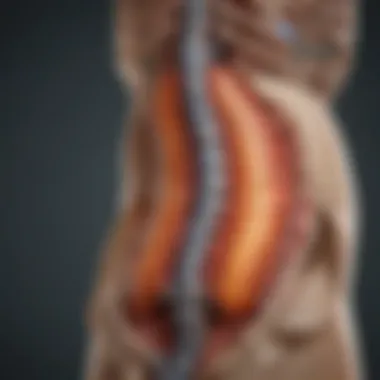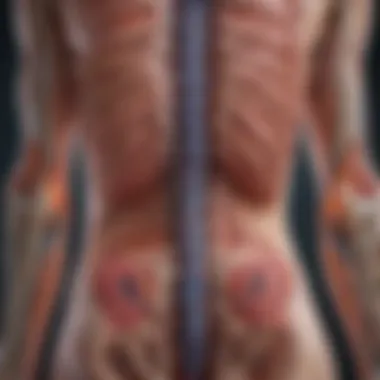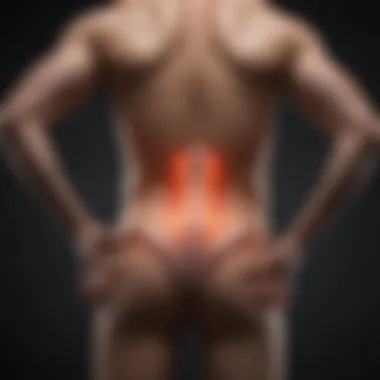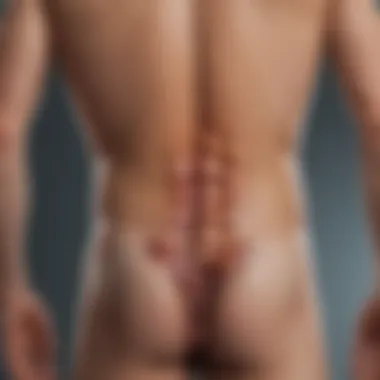Exploring the Link Between Low Back Pain and IBS


Intro
Low back pain and Irritable Bowel Syndrome (IBS) are two common conditions affecting millions of individuals worldwide. People often overlook how these two can be interconnected. Low back pain may not only arise from physical factors but also from the symptoms of IBS. This overlapping relationship merits exploration, considering its significant implications for treatment strategies and patient management.
Understanding the connection between low back pain and IBS requires examining various factors. These include physiological, neurological, and psychological elements. As new research emerges, the need for a multidisciplinary approach grows clearer. This article will analyze the latest findings, aiming to enhance comprehension for both healthcare practitioners and patients.
Key Concepts
Definition of the Main Idea
The relationship between low back pain and IBS can be described as complex. Low back pain refers to discomfort experienced in the lumbar region. It can result from injury, strain, or herniated disks. On the other hand, IBS is a gastrointestinal disorder. Symptoms often include abdominal pain, bloating, gas, and changes in bowel habits.
Both conditions are prevalent and can severely impact the quality of life. The co-occurrence of symptoms has led researchers to believe there may be underlying factors linking them.
Overview of Scientific Principles
The connection between these two conditions is thought to involve several principles:
- Physiological Factors: Both back pain and IBS involve inflammation. Inflammation can alter nerve pathways. This alteration might lead to both types of pain.
- Neurological Factors: The nervous system plays a critical role in how pain signals are processed. For instance, chronic pain in one area can amplify pain perception in another, creating a cycle of discomfort.
- Psychological Factors: Stress and anxiety are known contributors to both low back pain and IBS. They can exacerbate symptoms, leading to a decline in overall wellbeing.
"Understanding the shared mechanisms behind low back pain and IBS can significantly improve treatment outcomes."
"Understanding the shared mechanisms behind low back pain and IBS can significantly improve treatment outcomes."
Current Research Trends
Recent Studies and Findings
Many studies have sought to uncover the intricacies of this association. Recent findings suggest:
- Shared Neuropathways: Research indicates that certain nerve pathways may activate in both low back pain and IBS. This discovery hints at a possible shared mechanism ensuring diagnosis accuracy.
- Impact of Stress: Studies have shown that stress management in patients with IBS can lead to improved low back pain symptoms. This emphasizes the psychological link between the two.
Significant Breakthroughs in the Field
Several breakthroughs have contributed to this understanding:
- Increased Awareness: There is a growing recognition among healthcare providers about the association. Specialists are more likely to consider IBS in patients presenting with low back pain.
- Multi-faceted Treatment Approaches: Integrated treatment options that address both conditions simultaneously have become more common. Approaches include physical therapy, psychological support, and dietary changes.
In summary, understanding the connection between low back pain and IBS is vital. Insights gathered from ongoing research can foster improved treatment strategies, facilitating better patient outcomes. By employing a holistic approach, practitioners may find efficient ways to address both conditions effectively.
Understanding Low Back Pain
Low back pain is a prevalent concern that affects many individuals worldwide. Its significance is underscored by both the physiological and psychological implications it holds. The understanding of low back pain contributes not only to individual health management but also to broader public health initiatives that address its widespread occurrence.
When discussing low back pain, it is crucial to recognize its multidimensional nature. Awareness of its various types and symptoms can guide patients and healthcare professionals alike in the identification and treatment of this condition. Understanding low back pain promotes better health outcomes and informs strategies for prevention and management. This knowledge illuminates how back pain can complicate other health issues, making it essential in the context of conditions like Irritable Bowel Syndrome (IBS).


Defining Low Back Pain
Low back pain is defined as discomfort or pain felt in the lower back region, generally situated between the last rib and the top of the legs. The pain can arise from various structures, including muscles, ligaments, discs, and vertebrae. It can manifest differently, ranging from a dull ache to sharp pain that can limit mobility. This variation adds complexity to its treatment and understanding.
Prevalence and Incidence
Low back pain is one of the most common medical complaints globally. The World Health Organization estimates that about 60% to 80% of people will experience low back pain at some point in their lives. Its incidence is notably high among adults, particularly those aged between 30 and 50 years.
Understanding prevalence is key for health professionals. It highlights the need for effective management strategies and resource allocation. Various epidemiological studies reveal trends in demographics, such as gender and occupational factors, which can affect the incidence of low back pain.
Types of Low Back Pain
Acute Low Back Pain
Acute low back pain is typically defined as pain lasting less than six weeks. It often results from sudden trauma or injury, such as heavy lifting or awkward movements. This type of pain may improve significantly with conservative measures such as rest and physiotherapy.
The key characteristic of acute low back pain is its short duration. This feature makes it a primary focus in initial assessments, as timely intervention can prevent chronicity. Understanding acute pain allows for targeted treatment and informs patients about the possible prognosis.
Chronic Low Back Pain
Chronic low back pain is defined as pain that persists for over three months. It can arise from longstanding musculoskeletal issues, underlying health problems, or can even develop without an obvious cause. The duration of chronic pain presents unique treatment challenges and often requires a multidisciplinary approach.
A defining aspect of chronic low back pain is its impact on quality of life. Many patients experience depression or anxiety as a result of their ongoing pain. This connection emphasizes the importance of comprehensive management strategies that address both physical and emotional dimensions of health.
Radicular Pain
Radicular pain occurs when the pain radiates from the lower back down through the leg, often caused by nerve compression. This type of pain can result from herniated discs or spinal stenosis. It is characterized by symptoms such as tingling or weakness in the lower extremities.
Radicular pain is particularly notable because it may indicate more severe underlying conditions. Recognizing this type of pain helps in effective early diagnosis and treatment..
Common Causes and Risk Factors
The causes of low back pain are varied and complex. They can include physical injuries, degenerative diseases, poor posture, and obesity. Additionally, risk factors such as age, occupation, and lifestyle choices play significant roles in the development of low back issues.
Physical and Emotional Impact
The effects of low back pain extend beyond physical discomfort. Many individuals experience emotional distress, which can exacerbate their physical symptoms. This interplay between physical and emotional health underlines the need for an integrated approach to treatment.
Overview of Irritable Bowel Syndrome
Irritable Bowel Syndrome (IBS) plays a crucial role in understanding the connection between this digestive disorder and low back pain. Recognizing the characteristics of IBS is essential for both patients and medical professionals. This overview aims to highlight the significant elements that contribute to the complexity of the condition.
IBS is not just a simple gastrointestinal issue; it encompasses a range of symptoms that can severely affect quality of life. Its relevance in connection with low back pain cannot be overstated, as both conditions often coexist. This coexistence suggests potential overlapping mechanisms that warrant further exploration.
What is IBS?


Irritable Bowel Syndrome is a functional gastrointestinal disorder characterized by a combination of abdominal discomfort and altered bowel habits. These symptoms can vary widely among individuals, making IBS a multifaceted condition. Furthermore, unlike some gastrointestinal diseases, IBS does not stem from observable abnormalities in the gastrointestinal tract. It is essential to understand these characteristics, as they underscore the symptomatic nature of IBS.
Epidemiology of IBS
IBS affects millions of people globally, with varying prevalence rates across different populations. Studies indicate that approximately 10-15% of the adult population experiences IBS symptoms at some stage. The condition is notably more common in women than men, largely due to hormonal factors and differences in coping strategies. Recognizing these demographic trends can aid in better targeting treatment and management.
Symptoms and Diagnostic Criteria
- Abdominal Pain: Abdominal pain is a central symptom of IBS. It is often described as cramping and can fluctuate in intensity. The presence of this symptom is fundamental to diagnosing the disorder. Without understanding abdominal pain's classification, diagnosis remains incomplete. Its periodic nature can complicate patient accounts, making detailed records of symptom occurrence essential.
- Bloating: Bloating, or the sensation of fullness or swelling in the abdomen, is another hallmark symptom. This symptom can contribute to feelings of discomfort and is often linked with dietary choices. Managing bloating involves identifying potential trigger foods, as well as understanding its psychological implications that can exacerbate the sensation.
- Altered Bowel Habits: Patients with IBS may experience diarrhea, constipation, or alternating between both. Understanding altered bowel habits is essential, as they directly correlate with the diagnosis criteria for IBS. This symptom's variability can also affect treatment decisions, necessitating tailored approaches for individual patients.
Etiology and Pathophysiology
The underlying causes of IBS remain unclear; however, a combination of factors is thought to play a role. These include gut-brain axis disturbances, dysbiosis of gut microbiota, and increased gut permeability. Exploring these factors further enhances the potential for targeted treatments that address the root causes rather than solely the symptoms.
Psychosocial Factors in IBS
Psychosocial factors significantly influence IBS symptoms. Stress, anxiety, and depression are common in individuals with IBS. These factors do not just coexist; they can trigger or worsen gastrointestinal symptoms. Understanding the psychological landscape surrounding IBS is vital for holistic treatment approaches. Such perspectives can yield better patient outcomes when integrated into treatment plans.
Exploring the Link Between Low Back Pain and IBS
Understanding the connection between low back pain and Irritable Bowel Syndrome (IBS) is significant. Both conditions are prevalent and can affect daily functioning. Patients suffering from one often report symptoms related to the other, indicating a potential relationship. This intersection merits detailed investigation. By studying these links, healthcare providers can improve management strategies. This synergy can lead to a higher quality of patient care. Furthermore, understanding these connections can better inform research directions.
Comorbidity Studies
Comorbidity studies are crucial in revealing how low back pain and IBS coincide in patients. Research indicates that individuals suffering from chronic low back pain often experience gastrointestinal complaints. A substantial number of patients report IBS symptoms. According to various studies, the rates of overlap can exceed 30%. This high prevalence suggests underlying interactions that merit further exploration. Such data highlights the need for holistic treatment approaches.
Shared Physiological Mechanisms
Inflammation
Inflammation plays a critical role in both low back pain and IBS. Chronic inflammation can contribute to pain mechanisms, exacerbating discomfort in the back and abdomen. Key characteristics of inflammation include increased blood flow and immune responses. These factors affect muscle and nerve function, potentially intensifying pain. Understanding inflammation is beneficial for this topic because targeting it can help provide relief for patients suffering from both conditions.
The unique feature of inflammation is its dual role; while it can signal injury and initiate healing, it can become chronic, leading to ongoing issues. This characteristic can complicate treatment strategies as managing inflammation effectively remains a challenge.
Nervous System Interactions
Nervous system interactions also offer insights into the connection between low back pain and IBS. The autonomic nervous system regulates bodily functions. Dysregulation can lead to disturbances in both gastrointestinal and musculoskeletal systems. Notably, these interactions highlight the interconnected nature of body systems.
Key characteristics of nervous system interactions lie in their influence on pain perception and gut motility. This is a beneficial choice for this article as it emphasizes the importance of recognizing how nervous pathways can contribute to symptoms of both conditions. Unique to this aspect is the concept of the brain-gut axis, which suggests that psychological stress can exacerbate both pain and gastrointestinal issues. This connection can complicate treatment plans, as addressing one issue without considering the other may yield suboptimal results.
Psychological Overlaps
Psychological factors also play a role in the relationship between low back pain and IBS. Conditions such as anxiety and depression have been linked to both ailments. Patients with psychological stress may report heightened sensitivity to pain. This overlap suggests that mental health must be addressed within the management of both conditions. Understanding these psychological overlaps can foster comprehensive treatment strategies that consider emotional well-being alongside physical symptoms.
Impact of Stress and Anxiety


Stress and anxiety significantly impact both low back pain and IBS. Elevated stress levels can worsen both pain and gastrointestinal symptoms. When individuals experience stress, the body's primary response can lead to muscle tension and altered gut function.
The direct relationship between stress, pain perception, and bowel habits is well-documented. As stress intensifies, so do symptoms related to low back pain and IBS. Addressing stress can thus improve overall patient outcomes. This understanding highlights the necessity for individualized approaches in therapy, combining medical treatment with stress management techniques.
Management Strategies for Patients with Dual Symptoms
The management of patients experiencing both low back pain and Irritable Bowel Syndrome (IBS) calls for a nuanced approach. This is key not only to alleviate symptoms but also to improve the quality of life for individuals affected. Targeted strategies can address the unique challenges posed by these overlapping conditions. For example, understanding the interrelated nature of the symptoms can help practitioners to create effective management plans that encompass both physical and psychological aspects.
Integrated Treatment Approaches
An integrated treatment approach is essential when treating patients with both low back pain and IBS. This method combines various treatment modalities into a cohesive plan. The goal is to treat not just the symptoms but also to understand the underlying factors promoting these conditions. Collaboration among healthcare providers is crucial in tailoring treatment plans. This can include physiotherapy, nutritional guidance, and psychological counseling. Patients may greatly benefit from a unified strategy that reduces the risks of one treatment exacerbating the other condition.
Physical Therapy Options
Physical therapy serves as a cornerstone in managing low back pain and can also support IBS symptoms. Specific exercises designed to strengthen core muscles can lessen strain on the lower back. These can improve posture, which is beneficial for digestive processes as well. Moreover, physical therapists can use modalities like heat, ultrasound, and electrical stimulation to ease pain. Patient education on body mechanics and movement patterns is also a significant component of therapy. This empowers patients to engage in daily activities without aggravating their symptoms, thus promoting general well-being.
Pharmacological Interventions
Pain Management
The role of pain management in handling low back pain is crucial. Treatment may involve nonsteroidal anti-inflammatory drugs (NSAIDs) and acetaminophen to temporarily alleviate discomfort. A careful prescription of pain meds ensures that the overall treatment does not interfere with IBS symptoms. Pain management methods are favorable due to their rapid action and the quick relief they provide. However, a key feature to consider is the risk of dependency or side effects that can arise with long-term use.
IBS Specific Medications
Medications specifically targeted for IBS can help resolve digestive issues while still addressing the discomfort associated with low back pain. These drugs can include antispasmodics or laxatives, depending on the symptoms presented. The benefit of IBS specific medications lies in their direct approach to alleviating gastrointestinal discomfort. A unique feature is their ability to be tailored to the patient's specific IBS subtype, which can optimize treatment outcomes. However, side effects such as gastrointestinal upset must be considered, potentially complicating management.
Psychological Therapies
Mental health is often overlooked when treating physical symptoms. Psychotherapy, such as cognitive behavioral therapy (CBT), can be very beneficial in managing both low back pain and IBS. It addresses anxiety, stress, and emotional factors that might exacerbate pain perception and digestive issues. Mindfulness practices can also enhance a patient's coping mechanisms, allowing them to respond better to their dual symptoms. Integration of psychological therapies can result in significant improvement in quality of life.
Managing dual symptoms of low back pain and IBS requires a comprehensive and multidisciplinary approach, recognizing the complex interaction between physical and psychological health.
Managing dual symptoms of low back pain and IBS requires a comprehensive and multidisciplinary approach, recognizing the complex interaction between physical and psychological health.
Future Directions in Research
Future research into the connection between low back pain and Irritable Bowel Syndrome (IBS) is essential. Understanding the underlying mechanisms can lead to better management strategies for those suffering from both conditions. Current research often lacks a comprehensive approach that combines physiological, psychological, and neurological aspects. As there is growing recognition of the comorbidity of these disorders, directed studies are necessary to unravel their complex interplay. By emphasizing the importance of this research, we can improve patient outcomes and treatment efficacy.
Identifying Biological Markers
Identifying biological markers can revolutionize how we understand low back pain and IBS. These markers may include specific proteins, genetic variants, or other physiological indicators that correlate with the onset and severity of symptoms. By establishing these connections, healthcare professionals can develop targeted treatment plans. Furthermore, biological markers may assist in predicting which patients are more likely to experience both conditions, thereby optimizing care strategies. Doing so also promotes early intervention, possibly preventing chronic symptoms from developing.
Longitudinal Studies on Comorbid Conditions
Longitudinal studies are vital for gaining insights into the relationships between low back pain and IBS over time. Monitoring patients across extended periods will aid in understanding how these conditions evolve together. This kind of research can illuminate patterns that might not be evident in cross-sectional studies. For instance, it can reveal whether treating one condition positively impacts the other or if underlying factors exacerbate both simultaneously. Such knowledge is crucial for definitive management recommendations and could guide clinicians in creating more effective interventions.
Innovations in Treatment Modalities
Innovations in treatment modalities should focus on integrated approaches that consider both low back pain and IBS. Researchers are exploring new therapies, including biofeedback, mindfulness, and physical therapy, tailored specifically for patients with dual symptoms. Furthermore, advancements in pharmacological treatments that target neurophysiological pathways shared by both conditions may provide significant relief. Staying updated with these innovative strategies can enhance therapeutic options and optimize patient care, making it essential for future research to prioritize these avenues.
Enhancing Patient Education and Support
Educating patients and providing support is critical in managing both low back pain and IBS. Future directions should include creating comprehensive educational resources that inform patients about the interconnectedness of these conditions. Improved guidelines can empower patients to engage actively in their care. Support networks, whether online or in communities, can provide emotional backing and shared experiences. Thus, prioritizing resources for education and support can greatly enhance the overall management experience for patients.







